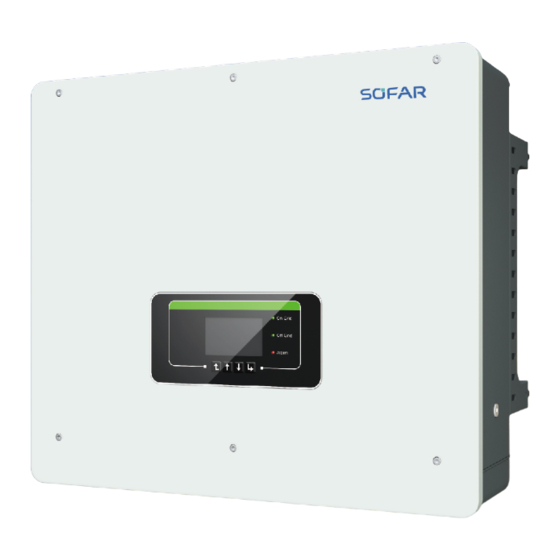
Table of Contents
Advertisement
Quick Links
Advertisement
Table of Contents

Summarization of Contents
1 About this manual
1.1 Copyright, Structure, and Scope
Covers copyright, manual structure, and the scope of the product manual.
1.4 Target Group and Symbols Used
Identifies the intended audience and explains safety symbols.
2 Basic Safety Information
2.1 Safety Information and Qualified Personnel
General safety rules and requirements for qualified personnel.
2.1.2 Installation, Transport, and Labeling
Guidelines for installation, transport, and labeling.
2.1.6 Operation Safety
Safety precautions during the operation of the inverter.
2.1.7 Repair and Maintenance Safety
Safety procedures for repair, maintenance, and handling of dangerous voltage.
2.2 Symbols and Signs
Explanation of safety symbols and signs.
3 Product Features
3.1 Product Information and Dimensions
Overview of inverter capabilities, specifications, and physical dimensions.
3.3 Labeling and 3.4 Functional Features
Details on device labels, functions, and electrical block diagram.
3.5 Connecting GTX 3000-H Batteries
Instructions for connecting GTX 3000-H battery systems.
3.6 Connecting BTS 5K Batteries
Instructions for connecting BTS 5K battery systems.
4 Installation
4.1 Installation Information and 4.2 Procedure
General installation guidelines, safety warnings, and step-by-step procedures.
4.3 Pre-Installation Checks
Checking packaging and delivery scope before installation.
4.4 Connections and 4.5 Tools
Required connections and tools for inverter installation.
4.6 Installation Environment Requirements
Specifications for the ambient environment for installation.
4.7 Installation Location and 4.8 Unpacking
Selecting the site and safely unpacking the inverter.
4.9 Inverter Installation Steps
Detailed steps for physically mounting and securing the inverter.
5 Electrical Connections
5.1 Safety Instructions and 5.2 Wiring Overview
Crucial safety advice and a general overview of wiring.
5.3 System Configurations
Description of system configurations for energy measurement.
5.4 Electrical Connection and 5.5 PE Cable
Procedures for electrical connection and PE cable grounding.
5.6 DC Lines for Battery
Detailed steps for connecting DC power cables to the battery.
5.7 AC Power Cables and 5.8 AC Connector
Connecting AC power cables and installing AC connectors.
5.9 Communication Interfaces
Details on communication ports and protocols for monitoring.
5.10 Feed-in Limitation Function
Configuration and use of the feed-in limitation function.
5.11 System Monitoring
Methods for system monitoring.
5.12 WiFi/Ethernet Stick Installation
Installation of WiFi and Ethernet communication sticks.
6 Commissioning the Inverter
6.1 Safety Test and 6.2 Double Check
Essential safety checks and verification before commissioning.
6.3 Starting the Inverter
Procedure for safely powering on and starting the inverter.
6.4 Initial Setup and Configuration
Steps for initial configuration, including language and channels.
6.5 Smartphone App and 6.6 Power Quality Modes
Using the SOFAR app and setting power quality modes.
7 Operation of the Device
7.1 Control Panel and Display
Overview of the control panel, buttons, and display indicators.
7.2 Standard Display Information
Details on information displayed on the inverter screen.
7.3 Energy Storage Modes
Explanation of energy storage modes: Self-use, Time-of-Use, Timing, Passive, Peak Shaving, Off-grid.
7.4 Menu Structure
Navigational structure of the inverter's menu system.
7.5 Firmware Update
Procedure for updating the inverter's software.
8 Troubleshooting Handling
8.1 Troubleshooting and Shutdown
Procedures for diagnosing issues and safe shutdown of the inverter.
8.1.2 Earth Fault Alarm
Information and handling of earth fault alarms.
8.2 Error List
Comprehensive list of error codes and solutions.
8.3 Maintenance
Guidelines for routine maintenance and cleaning.
















Need help?
Do you have a question about the ME 8KTL-3PH and is the answer not in the manual?
Questions and answers